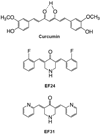Inhibition of the NF-κB signaling pathway by the curcumin analog, 3,5-Bis(2-pyridinylmethylidene)-4-piperidone (EF31): anti-inflammatory and anti-cancer properties
- PMID: 22197802
- PMCID: PMC3372981
- DOI: 10.1016/j.intimp.2011.12.009
Inhibition of the NF-κB signaling pathway by the curcumin analog, 3,5-Bis(2-pyridinylmethylidene)-4-piperidone (EF31): anti-inflammatory and anti-cancer properties
Abstract
Nuclear factor kappa B (NF-κB) is a key signaling molecule in the elaboration of the inflammatory response. Data indicate that curcumin, a natural ingredient of the curry spice turmeric, acts as a NF-κB inhibitor and exhibits both anti-inflammatory and anti-cancer properties. Curcumin analogs with enhanced activity on NF-κB and other inflammatory signaling pathways have been developed including the synthetic monoketone compound 3,5-Bis(2-fluorobenzylidene)-4-piperidone (EF24). 3,5-Bis(2-pyridinylmethylidene)-4-piperidone (EF31) is a structurally-related curcumin analog whose potency for NF-κB inhibition has yet to be determined. To examine the activity of EF31 compared to EF24 and curcumin, mouse RAW264.7 macrophages were treated with EF31, EF24, curcumin (1-100 μM) or vehicle (DMSO 1%) for 1h. NF-κB pathway activity was assessed following treatment with lipopolysaccharide (LPS) (1 μg/mL). EF31 (IC(50)~5 μM) exhibited significantly more potent inhibition of LPS-induced NF-κB DNA binding compared to both EF24 (IC(50)~35 μM) and curcumin (IC(50) >50 μM). In addition, EF31 exhibited greater inhibition of NF-κB nuclear translocation as well as the induction of downstream inflammatory mediators including pro-inflammatory cytokine mRNA and protein (tumor necrosis factor-α, interleukin-1β, and interleukin-6). Regarding the mechanism of these effects on NF-κB, EF31 (IC(50)~1.92 μM) exhibited significantly greater inhibition of IκB kinase β compared to EF24 (IC(50)~131 μM). Finally, EF31 demonstrated potent toxicity in NF-κB-dependent cancer cell lines while having minimal and reversible toxicity in RAW264.7 macrophages. These data indicate that EF31 is a more potent inhibitor of NF-κB activity than either EF24 or curcumin while exhibiting both anti-inflammatory and anticancer activities. Thus, EF31 represents a promising curcumin analog for further therapeutic development.
Copyright © 2011 Elsevier B.V. All rights reserved.
Conflict of interest statement
The authors have no conflicts of interest to declare, financial or otherwise, regarding findings presented in this manuscript.
Figures











Similar articles
-
Inhibition of IkappaB kinase-nuclear factor-kappaB signaling pathway by 3,5-bis(2-flurobenzylidene)piperidin-4-one (EF24), a novel monoketone analog of curcumin.Mol Pharmacol. 2008 Sep;74(3):654-61. doi: 10.1124/mol.108.046201. Epub 2008 Jun 24. Mol Pharmacol. 2008. PMID: 18577686 Free PMC article.
-
Design, synthesis, and biological evaluation of novel EF24 and EF31 analogs as potential IκB kinase β inhibitors for the treatment of pancreatic cancer.Drug Des Devel Ther. 2017 May 12;11:1439-1451. doi: 10.2147/DDDT.S133172. eCollection 2017. Drug Des Devel Ther. 2017. PMID: 28553074 Free PMC article.
-
A liposomal formulation of the synthetic curcumin analog EF24 (Lipo-EF24) inhibits pancreatic cancer progression: towards future combination therapies.J Nanobiotechnology. 2016 Jul 11;14(1):57. doi: 10.1186/s12951-016-0209-6. J Nanobiotechnology. 2016. PMID: 27401816 Free PMC article.
-
Alternative splicing in the NF-kappaB signaling pathway.Gene. 2008 Nov 1;423(2):97-107. doi: 10.1016/j.gene.2008.07.015. Epub 2008 Jul 22. Gene. 2008. PMID: 18718859 Free PMC article. Review.
-
Cell penetrating peptide inhibitors of nuclear factor-kappa B.Cell Mol Life Sci. 2008 Nov;65(22):3564-91. doi: 10.1007/s00018-008-8222-z. Cell Mol Life Sci. 2008. PMID: 18668204 Free PMC article. Review.
Cited by
-
Pomegranate peel polyphenols inhibits inflammation in LPS-induced RAW264.7 macrophages via the suppression of TLR4/NF-κB pathway activation.Food Nutr Res. 2019 Apr 23;63. doi: 10.29219/fnr.v63.3392. eCollection 2019. Food Nutr Res. 2019. PMID: 31073284 Free PMC article.
-
Role of Inflammatory Mediators, Macrophages, and Neutrophils in Glioma Maintenance and Progression: Mechanistic Understanding and Potential Therapeutic Applications.Cancers (Basel). 2021 Aug 23;13(16):4226. doi: 10.3390/cancers13164226. Cancers (Basel). 2021. PMID: 34439380 Free PMC article. Review.
-
Anti-Inflammatory Activity and Structure-Activity Relationships of Brominated Indoles from a Marine Mollusc.Mar Drugs. 2017 May 6;15(5):133. doi: 10.3390/md15050133. Mar Drugs. 2017. PMID: 28481239 Free PMC article.
-
A Priori Activation of Apoptosis Pathways of Tumor (AAAPT) technology: Development of targeted apoptosis initiators for cancer treatment.PLoS One. 2021 Feb 8;16(2):e0225869. doi: 10.1371/journal.pone.0225869. eCollection 2021. PLoS One. 2021. Retraction in: PLoS One. 2023 Jun 8;18(6):e0287148. doi: 10.1371/journal.pone.0287148. PMID: 33556062 Free PMC article. Retracted.
-
Regulatory effect of Balanites aegyptiaca ethanol extract on oxidant/antioxidant status, inflammatory cytokines, and cell apoptosis gene expression in goat abomasum experimentally infected with Haemonchus Contortus.Trop Anim Health Prod. 2024 Jul 4;56(6):195. doi: 10.1007/s11250-024-04023-w. Trop Anim Health Prod. 2024. PMID: 38963478 Free PMC article.
References
-
- Couzin-Frankel J. Inflammation bares a dark side. Science. 2010;330:1621. - PubMed
-
- Aggarwal BB, Shishodia S, Sandur SK, Pandey MK, Sethi G. Inflammation and cancer: how hot is the link? Biochem Pharmacol. 2006;72:1605–1621. - PubMed
-
- Tracy RP. Emerging relationships of inflammation, cardiovascular disease and chronic diseases of aging. Int J Obes Relat Metab Disord. 2003;27(Suppl 3):S29–S34. - PubMed
Publication types
MeSH terms
Substances
Grants and funding
LinkOut - more resources
Full Text Sources
Miscellaneous

